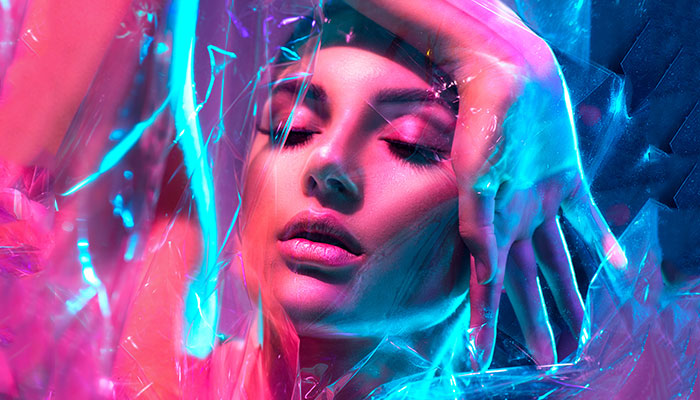
We all have our own digital rabbit holes that we love falling into and resist coming out of—sort of like an escape. Think Instagram, emails, video games, television, and to a certain extent, even video calls. Our faces are constantly exposed to digital screens the moment we wake up every morning to the very last minute before hitting the sack. And while we’re already aware of the damage it can cause to our eyes (like the sting in your eyes you experience after a long day), what most don’t know is that our skin is getting equally affected too—sometimes worse.
Blue light or also known as ‘High energy visible light’ is not only emitted from the sun but also from your devices. These traditions can actually cause your skin to age faster, leading to cell shrinkage, redness, pigmentation, and dullness that can have an immediate and lasting effect on the health of your skin. Considering the [problems concerning rapidly increased, especially during the post-pandemic world, we turned to MD and CEO of Cutis skin solution LLP Dr Apratim Goel for what blue light really means, its various sources, and why it’s crucial we gain knowledge on the subject.
Beauty Book: Why do we need blue light protection? What happens to our skin when exposed to it regularly?
Dr Goel: Remember as children we used to remember the colors of the rainbow by the acronym VIBGYOR? So, in this case, B stands for blue light ( about 380-500nm). What that basically means is that every shred of light that falls on your skin from daylight contains blue light. It doesn’t necessarily stop there. Research shows that blue light is also emitted from your devices like mobile phones, laptops, and television screens. When your skin is constantly exposed to blue light, it triggers free radical production which cascades into an inflammatory series of events. Eventually, it leads to collagen and elastin breakdown, melanin disruption, breakage of the epidermal barrier, and also lack of hydration. It also suppresses melatonin production in your body that regulates the circadian rhythm that eventually leads to sleep irregularities.
Beauty Book: What are the various sources of blue light? Can we avoid some of them through filters?
Dr Goel: The sources typically include the sun, and your electronic screens like mobile phones, laptops, and TV screens. The exposure from the sun can be minimized by using sunscreens. Coming to devices, you can use a filter screen or download apps that reduce the blue light emission to a large extent. However, more than devices, the emission and visible light from the sun is much higher and hence should be more of a concern whereas the blue light from digital screens is comparaticley less. And, while most use sunglasses with orange-tinted lenses that is said block blue light, we must keep in mind that these glasses also blocks end up blocking other colors, so I don’t recommend using them indoors, especially at night. Make sure you use glasses specifically deisgned for to block out only blue light must be used indoors.
Beauty Book: Can does one prevent blue light damage?
Dr Goel: Well in today’s digital age, “digital ageing” has become a big concern and it is the younger generation that are at greater risk here. Can we avoid the damage completely? Well, not altogether and while scientists are gathering more credible data to substantiate the tall claims of skin damage by blue light from the screen time, the key is to strike a balance between on and off time. The blue light emitted from our devices like mobiles, televisions, and laptops is not as powerful and damaging as compared to the blue light from sun and visible light. So some tips to avoid the cumulative damage include 1) Not using dim red lights while you sleep. Red light is less likely to suppress melatonin and cause sleep disturbance. 2) Using your device on safe mode will reduce a certain amount of blue light emission. Alternatively there are many apps that can be downloaded which use blue light screen filters. 3) Wearing blue light-blocking glasses. They are not very expensive. 4) Adding melatonin 3-5 mg daily in your supplementation.5) Exfoliating your skin, and providingdeep hydration and collagen regeneration has to be goal to be achieved by the skin care modification. 6) Using a sunscreen designed with blue light filter while watching television, using your mobile and laptop. Use the appropriate sunscreen indoors as well. Oral sunscreens like polypodium has been reported to have positive sun protection effect as well.
Beauty Book: Is blue light damage treatable? What can we do to heal our skin?
Dr Goel: Firstly, it is important for us to understand the damages that can be caused. Constant blue light exposure can cause changes like tanning, pigmentation and dullness to start with. The inflammation caused can also lead to oxidative damage which can destroy the collagen and elastic in the skin. This can cause sagging dull skin, fine lines, and wrinkles, along with open pores and dehyrdation. Since a poor sleep cycle is also related to inhibition of melatonin, under eye dark circles and puffiness could be triggered. Most of the changes that happen in your skin are irreversible especially after the age of 35-40 years. That’s why its important to take precautions against blue light from a very early age. The key to healing the skin is to be aware of the sources and consciously avoiding them.
Beauty Book: What ingredients should we look at whioe shopping for products for this concern?
Dr Goel: In general, all antioxidants and sun protection ingredients will reduce the blue light damage. Unfortunately there is not enough research that provide a specific list of blue light protection ingredients at this stage as this concern is relatively new. There are very few herbal and chemical products that have been specifically tested against protection from blue light damage. Most of them listed are general UV and light protection ingredients.
Beauty Book: What kind of ingredients or chemicals in blue-light protecting products should one avoid for sensitive skin? Can any protective ingredient harm the skin?
Dr Goel: Though sensitivity of skin can be very subjective, the ingredients I would worry about most in a sunscreen would be avobenzone, and oxybenzone. Safer ingredients include zinc oxide and titanium oxide.
Beauty Book: Is it enough to stick to skincare products or are surgical treatments or any recurrent dermatological procedures necessary?
Dr Goel: Yes, you wil stilll definitely need treatments with a dermatologist in addition to change in lifestyle, and skin care regime. The damaged collagen and elastin in the skin has to be regenerated using radiogrequency devices like multineedle RF ( Vivace) non-needle RF ( exilis, endymed etc), HIFU or ulthera, dermafrac or even skin boosters like Profilho or Restylane Vital. However the treatments needed will depend on the damage, repair desired and most importanttly a skin analysis.
Beauty Book: Blue light is also known to help our skin’s microbiome and treating acne. How does one balance the good and the bad?
Dr Goel: Blue light of all the colors of the spectrum has the highest energy and that makes it most powerful with highest penetration—blue light is also called HEV high energy visible light. As dermatologists, we have exploited this power of blue light from devices to treat acne, psoriasis and various other skin diseases. Back in 2002 when I started , I remember using this blue light device twice weekly for 20 minutes to reduce inflammation and erythema for acne, rosacea, psoriasi, and dermatitis.

